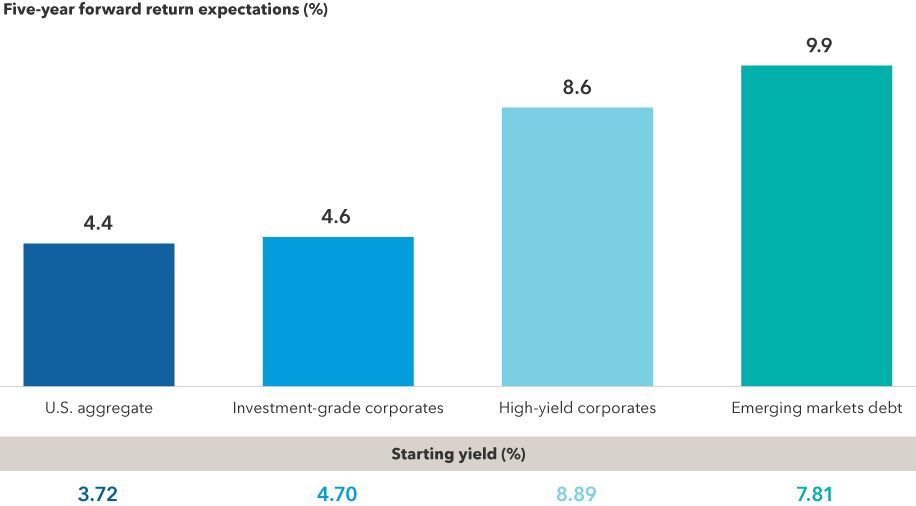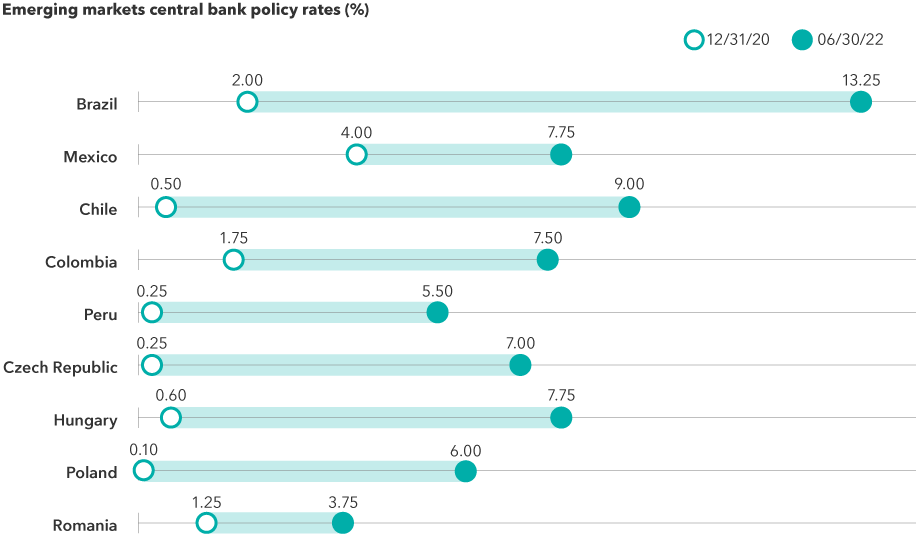Fixed Income
Rising inflation and slowing global growth are two dominant themes casting a pall over the current market environment. With increasing geopolitical uncertainty, tightening monetary policy, supply chain challenges and higher commodity prices at play, a period of global stagflation could potentially be on the horizon.
Navigating the foggy road to normal has never been more challenging, but with a long-term lens one can better understand the strong normalizing effect that disinflationary forces such as rising debt levels, technological advancements and aging demographics could have. Having a clear understanding of these can help investors better find their way.
Investing in fixed income during a time of a high inflation and rising rates can seem worrisome. However, today’s starting yields offer an attractive entry point for investors. Yields across fixed income sectors are sharply higher than their lows over the past few years. For example, investment-grade (BBB/Baa and above) corporate bonds currently offer a yield of 4.70%, which is higher than the 3.53% yield offered by high-yield corporate bonds during their recent lows.
Rising yields reflect more income potential across bond markets

Sources: Bloomberg Index Services Ltd., JP Morgan. As of 6/30/22. Sector yields above include Bloomberg U.S. Aggregate Index, Bloomberg U.S. Corporate Investment Grade Index, Bloomberg U.S. Corporate High Yield Index, 50% J.P. Morgan EMBI Global Diversified Index/50% J.P. Morgan GBI-EM Global Diversified Index blend and Bloomberg Municipal Bond Index. Period of time considered from 2020 to present. Dates for lows from top to bottom in chart shown are: 8/4/20, 12/31/20, 7/6/21, 1/4/21 and 7/27/21.
At current yields, history suggests higher total returns over the next few years. This means that investors could benefit from holding bonds across fixed income asset classes, including investment grade, high yield and emerging markets. This higher income can offer more of a cushion for total returns over time, even if price movements remain volatile. In fact, a greater portion of investors’ income needs could potentially be met with traditional fixed income than would have been the case in recent years.
Historically, at current yield levels, longer term returns have been strong

Sources: Capital Group, Bloomberg, J.P. Morgan. Yields and monthly return data as of June 30, 2022, going back to January 2000 for all sectors except emerging markets debt, which goes back to January 2003. Sector yields above include Bloomberg U.S. Aggregate Index, Bloomberg U.S. Corporate Investment Grade Index, Bloomberg U.S. Corporate High Yield Index, 50% J.P. Morgan EMBI Global Diversified Index/50% J.P. Morgan GBI-EM Global Diversified Index blend. Past results are not predictive of results in future periods.
Despite current volatility, the broad credit universe provides ample opportunities for investors to add value through bottom-up research and security selection in each of the four primary credit sectors — high yield, investment grade, emerging markets and securitized debt (or debt backed by auto loans, credit card receivables or other assets). Keeping a long-term view and employing balance can help smooth the way.
Notably, investment-grade corporate bonds have become more attractive as corporate fundamentals continue to improve, with relative debt levels falling across both European and U.S. investment-grade bonds. Valuations also look attractive as global investment-grade corporate yield has increased alongside higher government bond yields and wider spreads.
U.S. high-yield fundamentals have also been improving. The credit quality of the market has improved with a higher proportion of BB-rated companies and a lower share of CCC-rated bonds, which could potentially make the market more resilient to a slowdown in growth. Defaults are currently very low, and although they may pick up should we enter a recession, we believe the yield cushion and active security selection can offset the potential risks. Yields have also become more attractive, moving from the low levels reached in 2021 to 7.5% currently. However, as volatility is expected to remain high and a higher degree of uncertainty in the economy persists, we position our credit portfolios defensively focusing on fundamentals and bottom-up research.
The emerging market debt (EMD) universe has broadened and deepened significantly in the last few decades and, as the asset class has developed, it has become more appealing to a broader investor base. Issuance has increased thereby improving liquidity. That said, rising inflation, slowing global growth, tightening U.S. monetary policy and a soaring U.S. dollar have all weighed on the sector.
The Russia-Ukraine conflict has created an additional headwind relative to other comparably rated developed market corporate debt. However, there is reason to be optimistic about the future of emerging markets. Current yield levels can provide significant cushion to further volatility.
Emerging local currency debt has been the fastest-growing segment of the EMD asset class for quite some time and is now the largest part of the universe. We have a preference for local currency bonds. Compared with developed markets, EM central banks are much more advanced in their policy tightening. In addition, the increase in core inflation in emerging markets has generally been more modest than in developed markets. More aggressive rate hikes coupled with more muted inflation suggest good value in EM duration. In most of these markets hedging costs are high, so our duration exposure is primarily on an unhedged basis.
Many EM countries have aggressively hiked interest rates

Sources: Capital Group, Bloomberg, JPMorgan, Morningstar. As of 6/30/22.
Overall EM currencies remain undervalued, but selectivity remains crucial in assessing mainly those currencies from commodity exporters countries. We still have a constructive view on commodity prices because supply shortages haven’t been alleviated. In many cases, supply issues have actually deteriorated yet global activity is still reasonable. As such there is still a structural tailwind for commodity prices.
Securitized credit can also offer a diverse array of investment opportunity across asset-backed, commercial real estate, non-agency mortgage and collateralized leveraged loan sub-sectors. Many of the fundamental drivers of these sectors are distinct from corporate and sovereign credit. This brings diversity to a portfolio.
We are currently finding good value in the single-asset single-borrower (SASB) market. These niche investments create more concentrated risks than traditional commercial mortgage-backed securities (CMBS), but the market largely consists of very high-quality properties and lends itself to deep, property-specific fundamental research. This presents an opportunity for investors to gain access to specific assets that they find attractive. This sector is under-researched by many market participants, and this enables our team of securitized credit analysts to identify numerous mispriced investment opportunities.
Uncertainty will remain in markets for the foreseeable future, and the investment environment will be challenging for investors globally. However, there will continue to be opportunities for active managers with strong research capabilities to navigate these headwinds, and allocations to fixed income assets will remain as crucial as ever.
This commentary has been republished here with permission from Global Investor Group, publisher of Global Investor magazine. Additional charts and data were added by the Capital Ideas staff.
Investing outside the United States involves risks, such as currency fluctuations, periods of illiquidity and price volatility, as more fully described in the prospectus. These risks may be heightened in connection with investments in developing countries.
The return of principal for bond funds and for funds with significant underlying bond holdings is not guaranteed. Fund shares are subject to the same interest rate, inflation and credit risks associated with the underlying bond holdings. Investments in mortgage-related securities involve additional risks, such as prepayment risk, as more fully described in the prospectus. Higher yielding, higher risk bonds can fluctuate in price more than investment-grade bonds, so investors should maintain a long-term perspective. Bond ratings, which typically range from AAA/Aaa (highest) to D (lowest), are assigned by credit rating agencies such as Standard & Poor's, Moody's and/or Fitch, as an indication of an issuer's creditworthiness.
The Bloomberg U.S. Aggregate Index represents the U.S. investment-grade fixed-rate bond market.
The Bloomberg U.S. Corporate Investment Grade Index represents the universe of investment grade, publicly issued U.S. corporate and specified foreign debentures and secured notes that meet the specified maturity, liquidity, and quality requirements.
The Bloomberg U.S. Corporate High Yield Index covers the universe of fixed-rate, non-investment-grade debt.
The Bloomberg Municipal Bond Index is a market-value-weighted index designed to represent the long-term investment-grade tax-exempt bond market.
The 50% J.P. Morgan EMBI Global Diversified Index/50% J.P. Morgan GBI-EM Global Diversified Index blend is a uniquely weighted emerging market debt benchmark that tracks total returns for U.S. dollar-denominated bonds issued by emerging market sovereign and quasi-sovereign entities in addition to the universe of regularly traded, liquid fixed-rate, domestic currency emerging market government bonds to which international investors can gain exposure. The 50%/50% JP Morgan EMBI Global/JP Morgan GBI-EM Global Diversified blends the JP Morgan EMBI Global Index with the JP Morgan GBI-EM Global Diversified Index by weighting their cumulative total returns at 50% each. This assumes the blend is rebalanced monthly.
The market indexes are unmanaged and, therefore, have no expenses. Investors cannot invest directly in an index.
BLOOMBERG® is a trademark and service mark of Bloomberg Finance L.P. and its affiliates (collectively “Bloomberg”). Bloomberg or Bloomberg’s licensors own all proprietary rights in the Bloomberg Indices. Neither Bloomberg nor Bloomberg’s licensors approves or endorses this material, or guarantees the accuracy or completeness of any information herein, or makes any warranty, express or implied, as to the results to be obtained therefrom and, to the maximum extent allowed by law, neither shall have any liability or responsibility for injury or damages arising in connection therewith.
Don't miss our latest insights.
Our latest insights
-
-
Emerging Markets
-
Global Equities
-
Economic Indicators
-
RELATED INSIGHTS
Never miss an insight
The Capital Ideas newsletter delivers weekly insights straight to your inbox.
 Mike Gitlin
Mike Gitlin